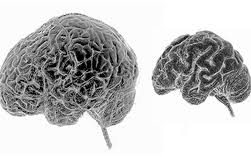
Smoking and the Nervous
System
The brain, which is positioned within the skull, is the master control organ of the whole body. It is small, pinkish gray in color, weighing just over 3 pounds and the size of two large fists. It looks like a wrinkled walnut and has a consistency similar to oatmeal. There are four distinct sections of the brain. The cerebrum, which is made up of four lobes, is the upper most and largest part of the brain where all higher cognitive function occurs and where incoming information is received, analyzed and stored. The diencephalon forms the central core of the brain and is surrounded by the two halves of the cerebrum. It controls many of the internal organs, maintains equilibrium throughout the body systems, and is the center for the emotions and sleep/wake cycle. The third section of the brain is the cerebellum, which is located to the back of the skull and lower than the cerebrum. It cooperates with the cerebrum and the brain stem to produce smooth, efficient muscular movement. Finally, the brain stem is the lowest part of the brain and is the center for both vital organ control and protective reflexes. The spinal cord is located from the brain stem downward through the vertebras of the back and is the pathway for all information that travels between the brain and the body, carrying both motor and sensory impulses. The peripheral nervous system is a complex set of 12 pairs of cranial nerves and 31 pairs of spinal nerves. The cranial nerves carry information to and from the brain and structures in the head, neck, stomach, and heart. The spinal nerves carry information from the spinal cord to the body that deals with sensory information from within the body and the environment coordinating both voluntary and involuntary muscle movement.
Once smoke from a cigarette is inhaled, it takes approximately 7 to 10 seconds for the brain to be affected by the nicotine, tar, and over 4,000 chemicals, causing every cell in the brain to be poisoned by the chemicals and also the excess CO that is carried in the blood. The resulting changes in the blood vessels—roughness, narrowing, hardening, and stickiness of the wall lining and weakening of the vessel wall—all increase the risk of strokes for the smoker. Although the exact cause is not known, both genetics and environmental factors seem to play a role in the development of muscular sclerosis. The white matter of the brain and spinal cord become inflamed, develop lesions and the myelin sheath surrounding the nerves is lost. Smoking may initiate this inflammation. Brain tumors and problems related to improper chemical transmission in the brain and nerve cells are also problems related to smoking. With this added knowledge, it is hard to understand why anyone would choose to smoke.
Janet Headrick